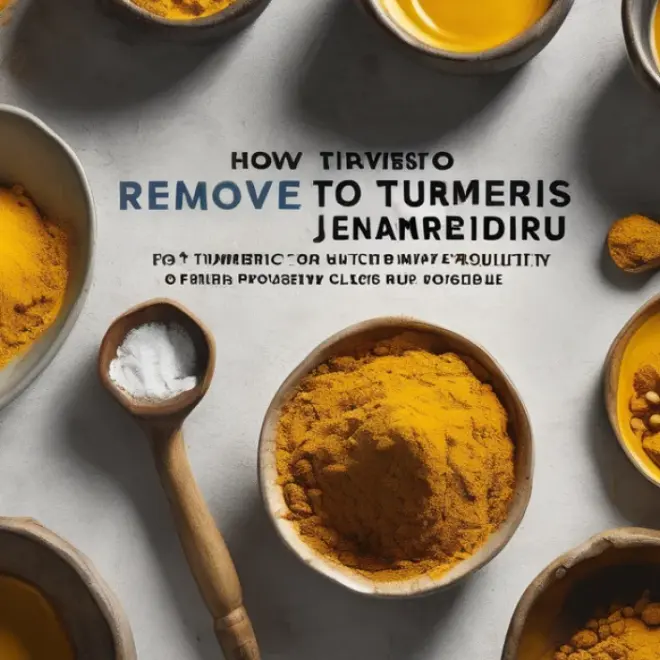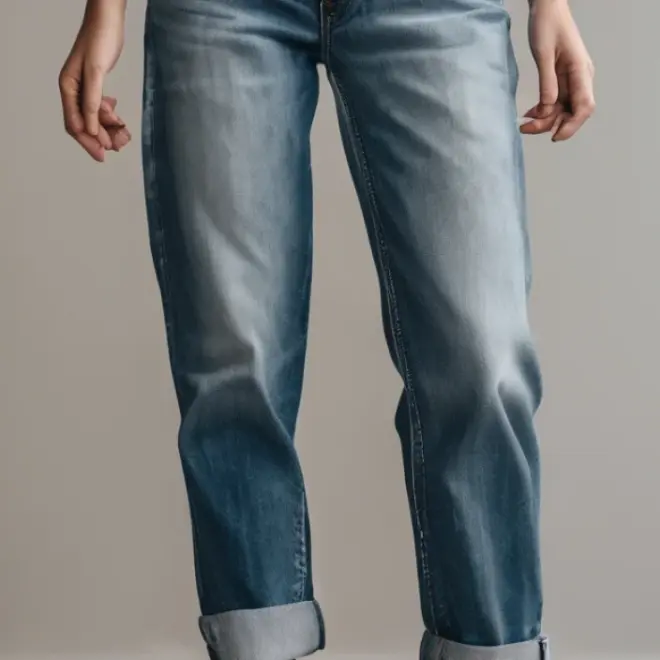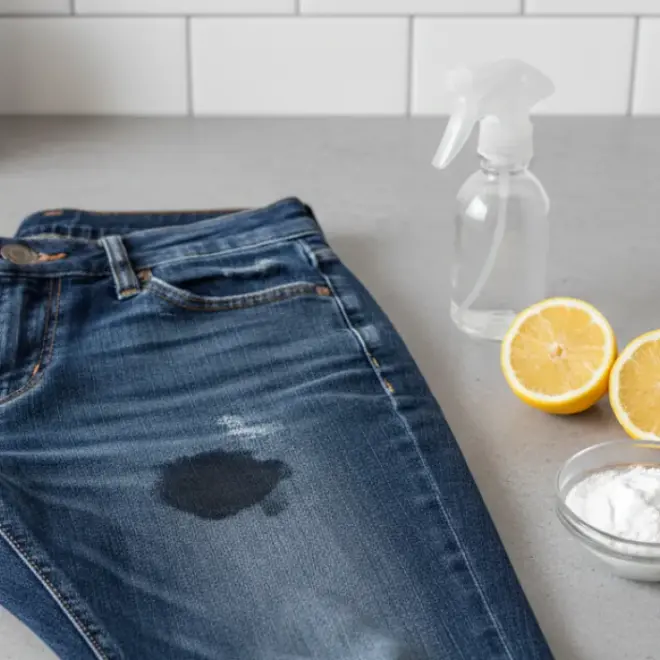To remove mustard from white jeans, act quickly! Gently blot excess mustard, then treat with a stain remover or a paste of baking soda and water before a cool wash cycle. For stubborn stains, a diluted vinegar or hydrogen peroxide solution can help, but always test on an inconspicuous area first.
White jeans are a wardrobe staple, perfect for sunny days and adding a crisp touch to any outfit. But let’s face it, white can be a magnet for stains, and mustard is a particularly notorious culprit. That bright yellow condiment can leave a stubborn mark that makes you want to sadly relegate your favorite pair to the back of the closet. But before you despair, know this: removing mustard from white jeans is absolutely achievable. With a few simple steps and the right approach, you can restore your jeans to their pristine glory. We’ll walk you through proven methods, from immediate first aid to tackling those tougher, set-in stains, ensuring your white denim stays looking its best.
Why Mustard Stains Are Tricky (But Fixable!)
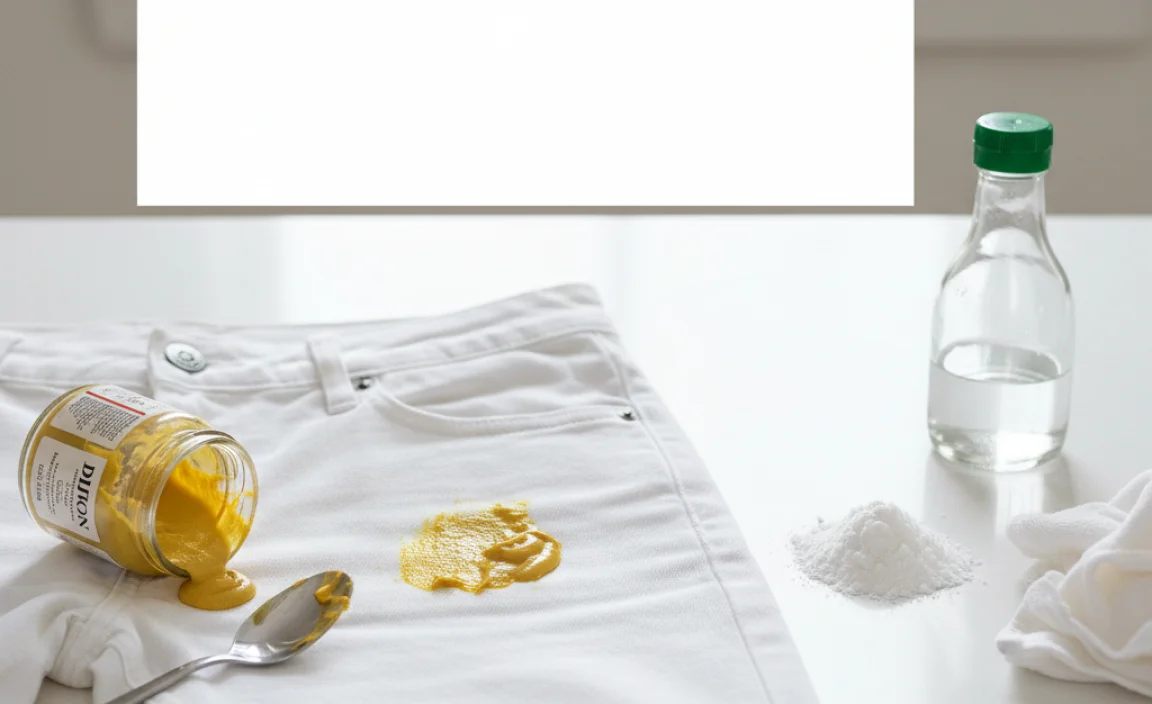
Mustard’s staining power comes from its key ingredients: turmeric, vinegar, and sometimes paprika or other spices. Turmeric contains a natural dye called curcumin, which is a potent chromophore, meaning it readily absorbs and reflects light in a way that creates color. This is why mustard stains are so vibrant. When this pigment gets into the fibers of your white jeans, it can be quite tenacious. The acidity from the vinegar can also sometimes “set” the stain if not treated properly.
However, the very things that make mustard a tough stain also give us clues on how to break it down. The turmeric pigment responds well to certain cleaning agents, and the acidity can be neutralized. The key is acting fast and using the right techniques.
Essential Tools for Mustard Stain Removal
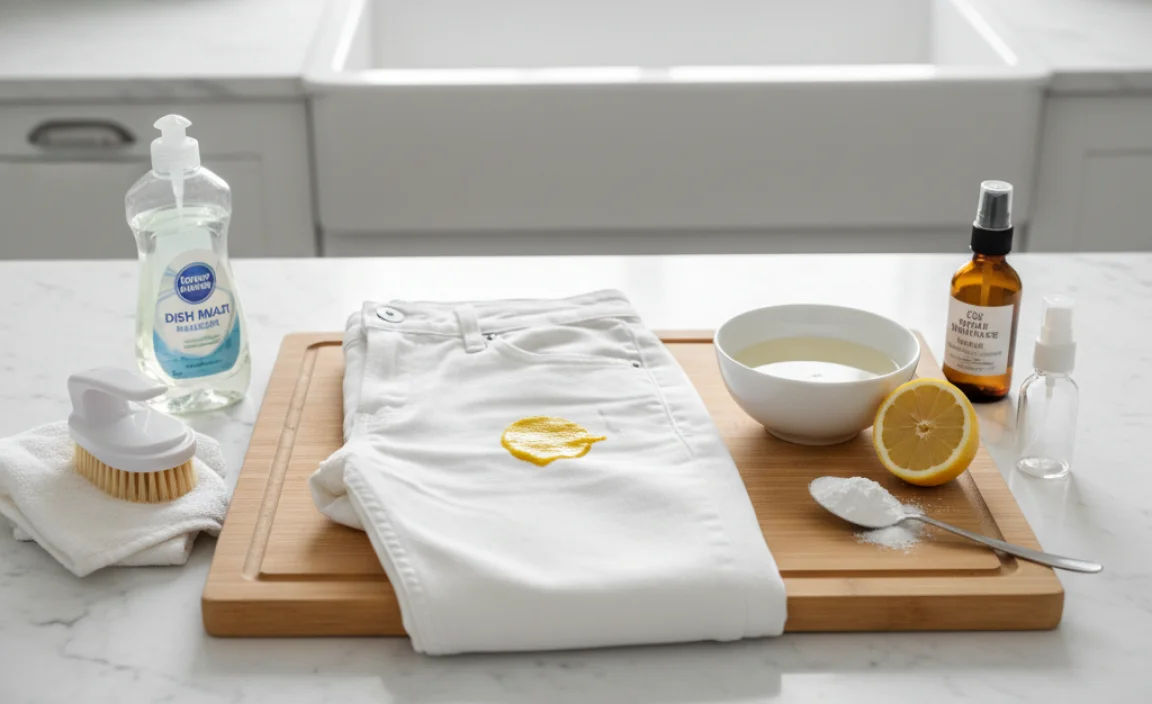
Before you dive in, gather these common household items. Having them ready will make the process smoother and more effective.
- Paper towels or clean, white cloths
- Mild liquid dish soap
- Baking soda
- White vinegar
- Hydrogen peroxide (3% solution)
- Rubbing alcohol (isopropyl alcohol)
- An old toothbrush or soft-bristled brush
- A small bowl
- Enzyme-based laundry pre-treatment spray or stain remover
- A tablespoon of salt (optional, for initial blotting)
The Immediate Action Plan: First Aid for Fresh Mustard Stains
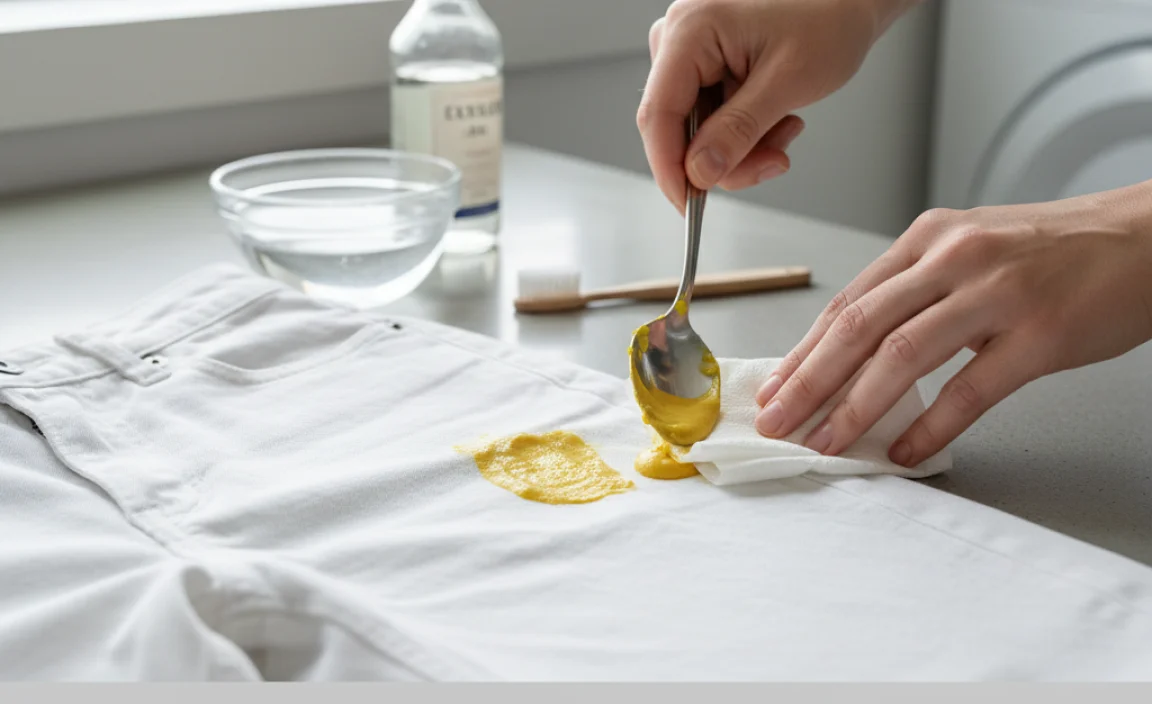
The golden rule for any stain, especially on white fabric, is to act as quickly as possible. The longer mustard sits on your jeans, the deeper it penetrates the fibers and the harder it will be to remove.
Step 1: Blot, Don’t Rub!
As soon as the spill happens, grab a paper towel or a clean white cloth. Gently blot the excess mustard from the surface of the fabric. It might be tempting to rub the stain, but this will only push the pigment further into the fibers and spread it, making the stain larger and more difficult to remove.
Step 2: Rinse with Cold Water
Turn the jeans inside out and hold the stained area under a stream of cold running water. Flush the stain from the back of the fabric. This helps to push the mustard out of the fibers rather than further in. Avoid hot water, as heat can set protein-based stains (though mustard isn’t primarily protein, heat can still set the dye aggressively).
Step 3: Apply a Gentle Cleaner
If the stain is still visible after rinsing, apply a small amount of mild liquid dish soap directly to the stained area. Gently work it into the fabric with your fingers or a soft brush. Let it sit for about 5-10 minutes.
Proven Methods for Removing Set-In Mustard Stains
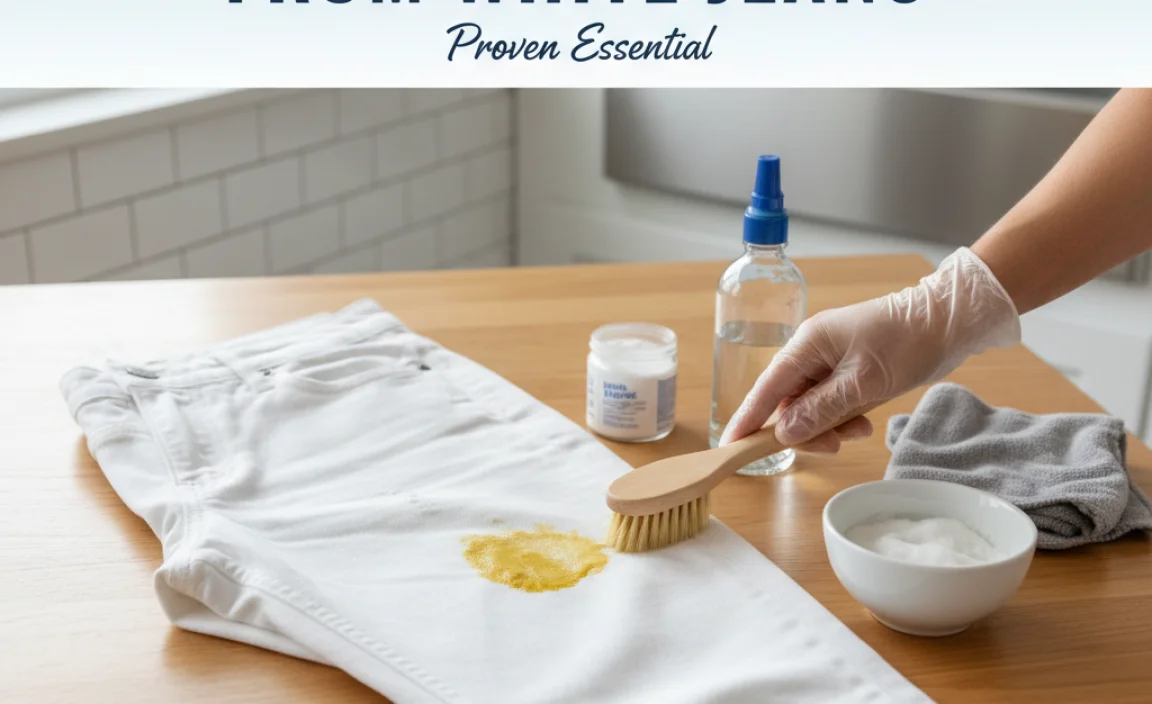
If the stain has had time to dry or the initial steps didn’t completely remove it, don’t worry. These methods are designed to tackle more stubborn stains on white denim. Always remember to test any cleaning solution on an inconspicuous area of the jeans first, like an inside seam or hem, to ensure it doesn’t damage or discolor the fabric.
Method 1: The Baking Soda Paste Power
Baking soda is a fantastic natural cleaner and deodorizer that’s gentle on fabrics. It works by absorbing the stain and acting as a mild abrasive.
- In a small bowl, mix two parts baking soda with one part water to create a thick paste.
- Gently apply the paste to the mustard stain, ensuring it covers the entire stained area.
- Let the paste dry completely on the stain. This can take several hours. As it dries, it will draw the stain out of the fabric.
- Once dry, gently brush off the dried paste with a soft-bristled brush or an old toothbrush.
- Launder the jeans as usual in cool water. Check if the stain is gone before drying.
Method 2: The Vinegar Solution Soak
White vinegar is acidic and can help break down the pigments in mustard. Diluting it is key to avoid damaging the fabric.
- Mix equal parts white vinegar and cool water in a bowl.
- Submerge the stained portion of the jeans in the vinegar solution.
- Let the jeans soak for about 30 minutes.
- Gently rub the stained area with your fingers or a soft brush.
- Rinse thoroughly with cold water.
- Launder the jeans as usual in cool water.
Important Note: Vinegar is acidic. Always rinse thoroughly after using vinegar to neutralize its effects on the fabric.
Method 3: Hydrogen Peroxide for Tough Stains
Hydrogen peroxide (3% solution, the common household kind) is a mild bleach that can be very effective on white fabrics. It works by oxidizing the stain molecules, breaking them down into colorless compounds.
- First, test a small, hidden area of your jeans with hydrogen peroxide to ensure it doesn’t cause any unwanted bleaching or damage.
- If the test is successful, apply a small amount of 3% hydrogen peroxide directly to the mustard stain. You can use a cotton ball or swab for precise application.
- Allow it to sit for about 10-15 minutes. You may see some gentle bubbling as it works.
- Gently blot the area with a clean, damp cloth.
- Rinse the area thoroughly with cold water.
- Wash the jeans as usual in cool water.
You can also combine this with a bit of baking soda to create a paste applied to the stain for extra oomph. For more information on the science behind stain removal with oxidation, consider resources like the American Cleaning Institute.
Method 4: The Power of Enzyme-Based Stain Removers
Commercial stain removers, especially those formulated with enzymes, are designed to break down specific types of organic stains. Enzymes are biological catalysts that can effectively target and degrade pigments like those found in mustard.
- Choose a reputable enzyme-based stain remover or laundry pre-treatment spray.
- Follow the product’s instructions carefully. Typically, you’ll spray or apply the product directly to the stained area.
- Allow the product to penetrate the stain for the recommended amount of time (often 15-30 minutes, or longer for tough stains).
- Gently work the product into the stain with your fingers or a soft brush.
- Launder the jeans as usual.
These products can be found at most grocery and department stores. Look for labels that mention enzyme action for organic stains.
Method 5: Rubbing Alcohol for Lingering Traces
Rubbing alcohol (isopropyl alcohol) can sometimes help lift residual stains. It acts as a solvent.
- Dab a clean white cloth or cotton ball with rubbing alcohol.
- Gently blot the mustard stain.
- You should see the stain transferring from the jeans to the cloth. Keep using a clean section of the cloth as you work.
- Once the stain appears gone or significantly lightened, rinse the area with cold water.
- Launder the jeans as usual.
Important Considerations and What to Avoid
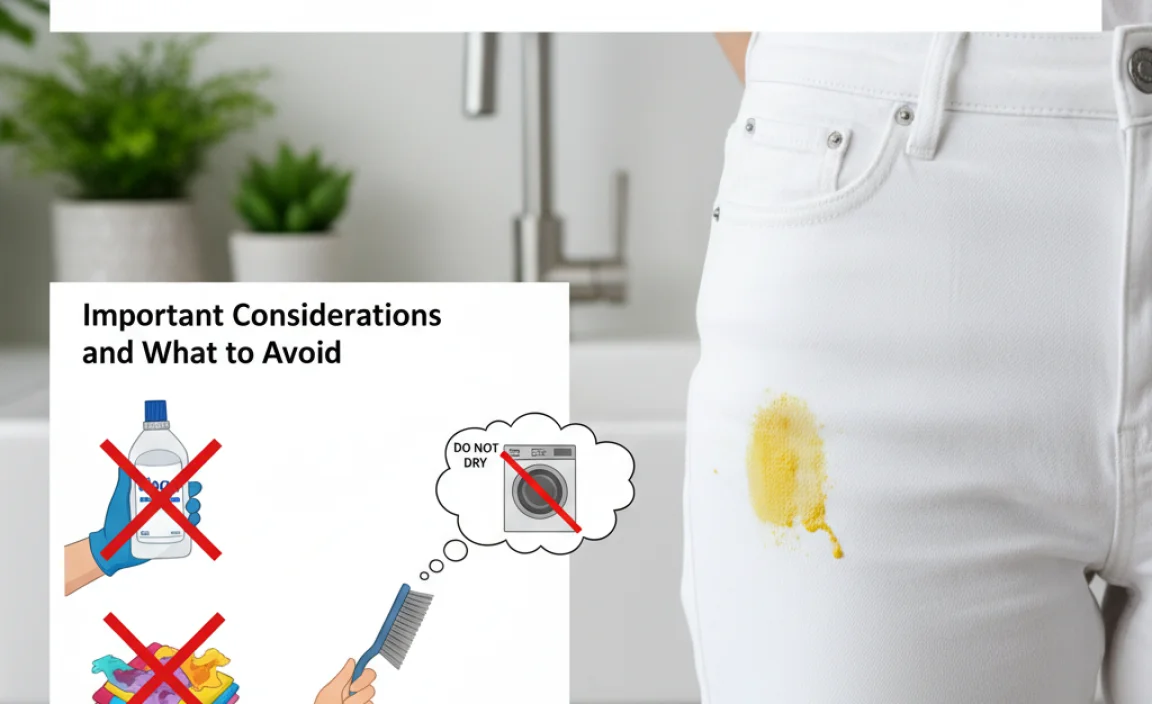
While these methods are effective, a few practices can make or break your stain-removal success.
What to Do:
- Always check the care label: Before trying any new method, consult the care label on your jeans for specific washing and cleaning instructions.
- Test first: As mentioned, always test cleaning solutions on an inconspicuous area.
- Be patient: Some stains may require multiple treatments. Don’t give up after the first try.
- Launder as usual AFTER stain removal: Once you’re confident the stain is gone, wash your jeans according to their care label.
- Air dry until sure: After treating a stain and washing, air dry your jeans. Heat from a dryer can permanently set any remaining stain residue. Once you’re absolutely certain the stain is gone, you can then machine dry them if desired.
What to Avoid:
- Hot Water: Never use hot water to treat a fresh mustard stain, as it can set the stain.
- Rubbing Aggressively: This can damage the fabric and spread the stain.
- Chlorine Bleach: While tempting for white fabrics, chlorine bleach can sometimes react with turmeric in mustard to create a pink or orange discoloration, making the stain even worse. Stick to gentler methods first or use oxygen-based bleaches cautiously if recommended by the product.
- Drying Before Stain is Gone: The heat from a dryer will likely make the stain permanent.
- Using Colored Cloths: Always use white cloths or paper towels to avoid transferring dye to your white jeans.
Comparing Stain Removal Methods
Each method has its strengths and might be more suitable depending on the age and severity of the stain. Here’s a quick comparison:
| Method | Best For | Pros | Cons |
|---|---|---|---|
| Baking Soda Paste | Fresh to moderately set stains | Gentle, natural, absorbs stain | Requires drying time, may need multiple applications |
| Vinegar Solution | Fresh to moderately set stains | Breaks down pigments, readily available | Can be harsh if not diluted, can leave its own scent |
| Hydrogen Peroxide (3%) | Stubborn, set-in stains | Mild bleaching action, effective on whites | Requires careful testing, can lighten fabric if overused |
| Enzyme-Based Remover | All types of organic stains, especially set-in | Specifically targets stain molecules, highly effective | Commercial product required, follow instructions precisely |
| Rubbing Alcohol | Lingering traces or light stains | Acts as a solvent, quick for minor spots | Can be drying to fabric, test for colorfastness |
The choice often comes down to what you have on hand and the urgency of the situation. For most beginners, starting with baking soda or a gentle dish soap followed by laundry is the safest bet.
Preventing Future Mustard Mishaps
While accidents happen, a few habits can help keep your white jeans pristine:
- Be Mindful: When eating messy foods like hot dogs or burgers with mustard, especially when wearing white, be extra cautious. You might consider rolling up the hems of your jeans or opting for a more forgiving outfit on those occasions.
- Use a Napkin: Keep a napkin handy, especially when dabbing your mouth or cleaning hands.
- Pre-treat Susceptible Areas: If you’re particularly prone to spills, a fabric protector spray designed for clothing might offer some resistance.
Frequently Asked Questions About Mustard Stains on White Jeans
Q1: Can I use bleach on mustard stains on white jeans?
It’s generally best to avoid chlorine bleach on mustard stains. The curcumin in mustard can react with chlorine bleach and turn the stain pink or orange, making it harder to remove. Oxygen-based bleaches are a safer alternative if you choose to use a bleach product.
Q2: How long should I let a stain remover sit on the jeans?
Always follow the specific product instructions. For most enzyme-based pre-treatments, 15-30 minutes is common, but some may suggest longer for tough stains. Baking soda paste needs to dry completely, which can take hours.
Q3: What if the stain is old and has been through the dryer?
An old, heat-set stain is much harder to remove. You’ll likely need multiple treatments with a strong enzyme cleaner or hydrogen peroxide. Be prepared that it might not come out completely.
Q4: Can I use a color catcher sheet in the wash with white jeans after treating a stain?
Yes, a color catcher sheet is a good idea to use when washing white items, especially after stain treatment, to absorb any stray dye that might be released during the wash cycle.
Q5: Is it safe to mix different stain removal products?
No, it’s generally not advisable to mix different cleaning chemicals. Some combinations can create dangerous fumes or damage your fabric. If one method doesn’t work, rinse thoroughly and try another method separately.
Q6: What is a good home remedy if I don’t have commercial stain removers?
Baking soda paste, white vinegar solution, and hydrogen peroxide (3%) are excellent home remedies that can be very effective for mustard stains on white jeans.
Conclusion: White Jeans Saved!
Dealing with a mustard stain on your favorite white jeans can be stressful, but as you’ve seen, it’s a challenge you can overcome. By acting quickly with gentle blotting and cold water, and then employing proven methods like baking soda paste, vinegar soaks, or hydrogen peroxide, you can effectively lift even stubborn stains. Remember to always test treatments on a hidden area and avoid heat until you are certain the stain is gone. With a little patience and the right approach, your white jeans will be back to their bright, stylish best, ready for your next wear. Happy cleaning!







